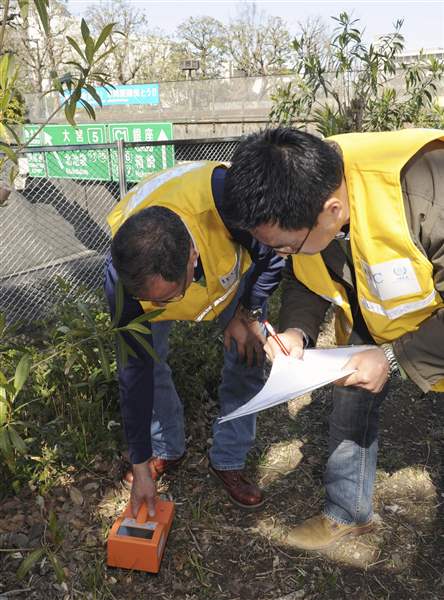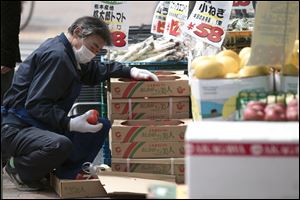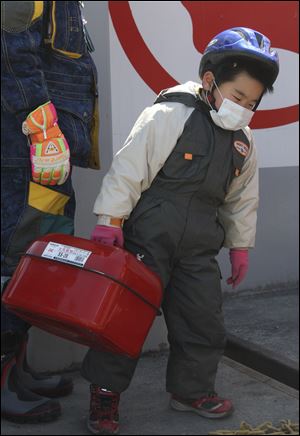
Japan finds more types of radiation-tainted food
3/20/2011
Officials from the United Nations International Atomic Energy Agency measure radiation exposure at a park in Tokyo. Minuscule amounts of radioactive iodine were found in tap water in Tokyo although experts said none of the tests showed health risks.
ASSOCIATED PRESS

Japan announced the first signs that contamination from its tsunami-crippled nuclear complex have seeped into the food chain, saying that radiation levels in spinach harvested in Ibaraki Prefecture and milk from farms in Fukushima Prefecture near the facility exceeded government safety limits.
Ministry official Yoshifumi Kaji said Sunday that tests found excess amounts of radioactive elements on canola and chrysanthemum greens, in addition to spinach. He said the areas where the tainted produce was found included three prefectures that previously had not recorded such contamination.
Kaji said it was possible that some tainted foods may already have been sold. He also said that the government ordered shipments of milk from Fukushima, where the plant is located, to be halted after finding tainted milk at four farms out of 37 tested.
Japan announced the first signs that contamination from its tsunami-crippled nuclear complex have seeped into the food chain, saying that radiation levels in spinach and milk from farms near the facility exceeded government safety limits.
Japanese officials insisted the radiation posed no immediate health threat and said the situation at the Fukushima Daiichi plant, though unpredictable, appeared to be coming under control after near-constant dousing of water to prevent spent fuel rods from burning up.
Emergency teams using an unmanned vehicle to spray water onto the most at-risk of the plant's six reactors launched a new round Sunday — aimed at the plant's Unit 4 — while preparing to switch power back on for the first time since a March 11 earthquake and tsunami knocked out the plant's crucial cooling systems.
There is no guarantee the cooling systems will work even once power is restored.
Japan has been struggling with a series of disasters prompted by the 9.0-magnitude quake.
The quake spawned a tsunami that ravaged Japan's northeastern coast, killing more than 7,600 people and knocking out cooling systems at the plant, prompting overheated reactors and fuel to leak radiation.
More than 11,000 people are still missing and more than 450,000 are living in shelters.
The government's top spokesman, Chief Cabinet Secretary Yukio Edano, said Saturday that tainted milk and spinach were collected from several farms ranging from 20 miles to 75 miles away from the reactors.
After the announcements, Japanese officials immediately tried to calm the public, saying the amounts detected were so small that people would have to consume unimaginable amounts to endanger their health.
"These levels do not pose an immediate threat to your health," Mr. Edano said. "Please stay calm."

Officials from the United Nations International Atomic Energy Agency measure radiation exposure at a park in Tokyo. Minuscule amounts of radioactive iodine were found in tap water in Tokyo although experts said none of the tests showed health risks.
Minuscule amounts of radioactive iodine also were found in tap water Friday in Tokyo and elsewhere in Japan — although experts said none of those tests showed any health risks.
The Fukushima prefecture asked dairy farms within 18 miles of the nuclear plant to halt all milk shipments.
Food safety inspectors said the amount of iodine-131 found in the tested milk was five times higher than levels deemed safe.
They said the iodine found in the spinach was more than seven times higher.
The spinach also contained slightly higher amounts of cesium-137.
Iodine-131 and cesium-137 are two of the most dangerous elements that are feared to have been released from the plants in Fukushima.
Iodine-131 can be dangerous to human health, especially if absorbed through milk and milk products, because it can accumulate in the thyroid and cause cancer.
Cesium-137 can damage cells and lead to an increased risk of cancer.
Those levels are well beyond what the Food and Drug Administration in the United States considers a cause for concern.
But experts say Japan's reassurances about food safety were probably accurate.
Dr. Harold Swartz, a professor of medicine at Dartmouth who studies radiation exposure in people, said the contamination levels were low and that the government's advice was "probably reasonable."
But, he added, because people are so afraid of radiation, they are likely to avoid these foods altogether.
Dr. Swartz said the radiation levels detected so far were still far lower than those at Chernobyl, the nuclear plant that exploded in Ukraine in 1986 and is still the world's worst nuclear accident.
He said he thought that in the United States food with similar levels of radiation would be taken off the market, but more for political and public relations reasons than for scientific or medical ones.

Six-year-old Satoshi Komatsu carries a gasoline container at a gas station in northern Japan’s Iwate prefecture.
At the Fukushima plant, about 500 workers have been thrown into the effort to keep the nuclear fuel cool and reconnect the plant to the power grid.
Mr. Edano said conditions at the reactors in Units 1, 2, and 3 — all of which have been rocked by explosions in the past eight days — had "stabilized."